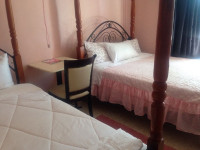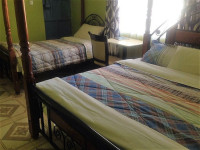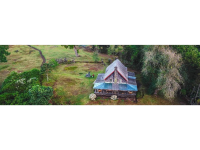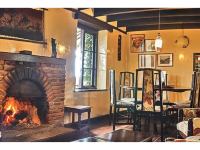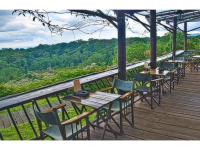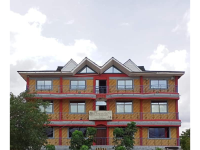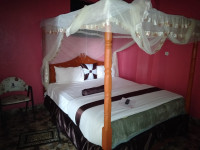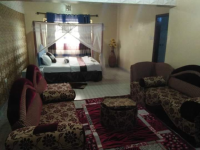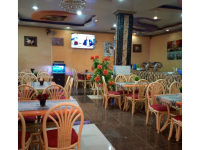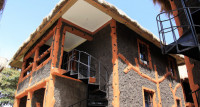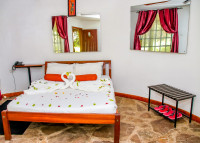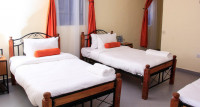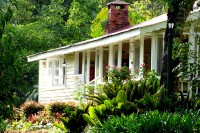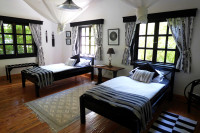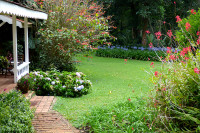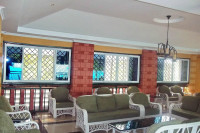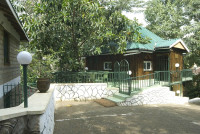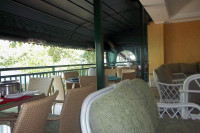
$2,750 pp (USD)
2 travelers on Start dateArrival
Arrival

Day 1
Pick up from Nairobi and Game Drive at Nairobi National Park
Pick up from Nairobi and Game Drive at Nairobi National Park
Nairobi National Park is currently lush after recent rains, offering excellent wildlife viewing opportunities. Early mornings are best for predators.
Bird Species: Common Ostrich, Secretarybird, Kori Bustard, Grey Crowned Crane, African Fish Eagle, Vulturine Guineafowl, Yellow-billed Stork, Blacksmith Lapwing, Lilac-breasted Roller, Superb Starling, and many more.
Mammal Species: Lion, Leopard, Cheetah, Black Rhinoceros (critically endangered), Cape Buffalo, Giraffe, Zebra, Common Eland, Hartebeest, Grant's Gazelle, Thomson's Gazelle, Impala, Hippopotamus (along Mbagathi River), and many more.
- Main Destination:
- Nairobi National Park
- Accommodation:
- Nairobi Transit Lounge
- Meals & Drinks:

Day 2
Drive to the Foothills of Mt Kenya, Detour at Sagana to Search for ElusiveHinde's Babbler
Drive to the Foothills of Mt Kenya, Detour at Sagana to Search for ElusiveHinde's Babbler
Sagana (Hinde's Babbler Search) and Mt Kenya Foothills later in the afternoon to dark (Castle forest).
Sagana's river valleys and swampy areas with dense thicket (including Lantana camara) are crucial for the elusive Hinde's Babbler, a vulnerable species. Success depends on patience and local knowledge.
Other possible Bird Species: Hinde's Babbler (target species), African Paradise Flycatcher, Grey-capped Warbler, African Golden Oriole, Red-chested Cuckoo, Speke's Weaver, Baglafecht Weaver, Grey-backed Camaroptera, Green-backed Honeyguide, African Emerald Cuckoo, and many others.
Mammal Species: Sykes' Monkey, Olive Baboon, Bushbuck, Common Duiker, Suni, Tree Hyrax, and various small rodents. (Larger mammals are less common but may be present in forest patches.).
- Main Destination:
- Mount Kenya
- Accommodation:
- Castle Forest Lodge
- Meals & Drinks:

Day 3
Nature Walk while Birding at Castle Forest for Half-day, Afternoon Drive to Samburu County
Nature Walk while Birding at Castle Forest for Half-day, Afternoon Drive to Samburu County
Castle Forest Birding again in the morning and afternoon, and drive to Samburu County.
Castle Forest offers a diverse high-altitude forest birding experience. Recent sightings include Willow Warbler, Chiffchaff, Blackcap, African Broadbill, Slivery-cheeked Hornbill, Hartlaub's Turaco, Olive Ibis, Taccaze Sunbird, Steaky Seed-eater, Mountain Buzzard, Ayres's Hawk-Eagle, Abyssinian Ground Thrush, Oriole Finch, African Hill Babbler, Montane White-eye, Thick-billed Seedeater, Crowned Eagle, and more.
Mammal Species: Colobus Monkey, Sykes' Monkey, Leopard, Bushbuck, Giant Forest Hog (elusive), Hyrax, Common Genet. Elephant and Buffalo also occur, though sightings are less frequent than in our next larger parks.
The drive to Samburu will take you through changing landscapes.
- Main Destination:
- Shaba National Reserve
- Accommodation:
- Grande Hotel Isiolo
- Meals & Drinks:

Day 4
Game Drive at Shaba and Buffalo Springs National Reserve
Game Drive at Shaba and Buffalo Springs National Reserve
These reserves are known for their arid northern Kenya specials. Expect dry conditions, but the Ewaso Nyiro River provides a lifeline for wildlife. Recent reports indicate good elephant sightings.
Bird Species: Somali Ostrich, Vulturine Guineafowl, Abyssinian Ground Hornbill, Golden-breasted Starling, Buff-crested Bustard, Rosy-patched Bushshrike, Northern Grey Tit, Bare-eyed Thrush, Somali Courser, Yellow-billed Hornbill.
Mammal Species: Grevy's Zebra, Reticulated Giraffe, Gerenuk, Beisa Oryx, Somali Ostrich (often grouped with mammals due to size and unique status), Lion, Leopard, Cheetah, African Elephant, Cape Buffalo, Lesser Kudu, Greater Kudu, Grant's Gazelle, Eland, and more.
- Main Destination:
- Buffalo Springs National Reserve
- Accommodation:
- Grande Hotel Isiolo
- Meals & Drinks:

Day 5
Drive to Naivasha, Detour to try Mackinder's Eagle Owl, Nature Walk at Crater Lake Sanctuary
Drive to Naivasha, Detour to try Mackinder's Eagle Owl, Nature Walk at Crater Lake Sanctuary
Transfer to Naivasha, try Mackinder's Eagle Owl on the way, and afternoon at Dark Crater Lake Sanctuary.
Naivasha is a renowned birding hotspot. Mackinder's Eagle Owl is challenging but possible on our way to Naivasha, often found roosting in rocky areas. Early arrival at Naivasha. You'll visit Crater Lake Sanctuary, which offers a unique blend of forest and lake habitats.
Bird Species: Mackinder's Eagle Owl (target species), African Fish Eagle, Goliath Heron, Great White Pelican, Lesser Flamingo (seasonal), African Jacana, Malachite Kingfisher, Pied Kingfisher, Black-headed Gonolek, White-faced Whistling Duck, lovebirds, francolins, honeyguides, and more.
Mammal Species: Hippopotamus, Giraffe, Zebra, Common Waterbuck, Bushbuck, Vervet Monkey, Black-and-white Colobus Monkey, Impala, Grant's Gazelle, Aardvark (nocturnal), Banded Mongoose, and others.
- Main Destination:
- Lake Naivasha (Naivasha)
- Accommodation:
- Dove Nest Lodge
- Meals & Drinks:
Day 6
Birding at Kinangop Grassland in the Morning, Afternoon Boat Trip at the Naivasha Ramsar Site
Birding at Kinangop Grassland in the Morning, Afternoon Boat Trip at the Naivasha Ramsar Site
Nature walk birding at Kinangop Grassland and Lake Naivasha Ramsar Site again to see what you missed.
Kinangop Grassland is vital for endemic and grassland species, particularly Sharpe's Longclaw and Jackson's and Long-tailed Widowbird, and Golden-winged Sunbird is possible. The Naivasha Ramsar site offers diverse aquatic birdlife.
Bird Species: Sharpe's Longclaw (endemic), Jackson's Widowbird, Long-tailed Widowbird, Grassland Pipit, Levaillant's Cisticola, African Snipe, Streaky Seedeater, Yellow-crowned Canary, Common Stonechat, Hunter's Cisticola.
Mammal Species: Marshbuck (Sitatunga - elusive in marshy areas), Defassa Waterbuck, Common Eland, Olive Baboon, Vervet Monkey, Serval (elusive), African Hare, various small rodents and shrews.
- Main Destination:
- Kinangop Grasslands
- Accommodation:
- Dove Nest Lodge
- Meals & Drinks:

Day 7
Morning Birding at Hell's Gate, Afternoon Transfer to Kakamega Forest
Morning Birding at Hell's Gate, Afternoon Transfer to Kakamega Forest
You'll experience Hell's Gate in the morning and transfer to Kakamega Forest in the afternoon.
Hell's Gate offers opportunities for unique sightings. The drive to Kakamega is long but scenic, traversing diverse landscapes.
Bird Species: Rüppell's Vulture, Verreaux's Eagle, Augur Buzzard, Swahili Sparrow, African Grey Hornbill, Fischer's Lovebird, Helmeted Guineafowl, Speckled Pigeon, Montane Nightjar, White-rumped Swift.
Mammal Species: Zebra, Common Eland, Grant's Gazelle, Thomson's Gazelle, Klipspringer, Impala, Olive Baboon, Vervet Monkey, Aardwolf (nocturnal), Rock Hyrax. Leopard and serval are present but very elusive.
- Main Destination:
- Hell’S Gate National Park
- Accommodation:
- Rondo Retreat
- Meals & Drinks:

Day 8
Nature Walk Birding at Kakamega Forest with a Site Guide
Nature Walk Birding at Kakamega Forest with a Site Guide
Kakamega Forest - Nature Walk Birding
Current Details: Kakamega Forest is Kenya's only rainforest, boasting high avian diversity and unique forest species. A local site guide is essential for spotting the more elusive birds.
Bird Species: Great Blue Turaco, Yellow-spotted Barbet, Turner's Eremomela (endemic), Blue-headed Bee-eater, Chapin's Flycatcher, Red-headed Malimbe, White-headed Wood Hoopoe, African Broadbill, Equatorial Akalat, Purple-throated Cuckoo-shrike.
Mammal Species: Red-tailed Monkey, Blue Monkey, Colobus Monkey, Giant Forest Squirrel, Lord Derby's Anomalure (flying squirrel), Forest Hog, Bushpig, African Civet, Potto (nocturnal). The leopard is present but rarely seen.
- Main Destination:
- Kakamega Forest
- Accommodation:
- Rondo Retreat
- Meals & Drinks:
Day 9
Kakamega Forest for 2-3hrs, Late Morning Drive to bird at Lake Victoria at Kisumu
Kakamega Forest for 2-3hrs, Late Morning Drive to bird at Lake Victoria at Kisumu
Kakamega early in the morning and Lake Victoria (Kisumu) afternoon birding.
This is another morning in Kakamega to consolidate sightings, then a drive to Lake Victoria, Kisumu, for specialized wetland birding.
Bird Species (Kakamega): Additional forest species, potentially including what was missed previously.
Bird Species (Lake Victoria/Kisumu): Papyrus Gonolek, Swamp Flycatcher, Northern Brown-throated Weaver, Double-toothed Barbet, African Thrush, Eastern Plantain-eater, African Skimmer, Malachite Kingfisher, Lesser Jacana, Long-tailed Cormorant, and quite others
Mammal Species (Lake Victoria/Kisumu): Hippopotamus, Spotted-necked Otter, Marsh Mongoose, Sitatunga (in papyrus swamps - elusive), various small rodents.

Day 10
Birding on the way back to Nairobi | Morning Charter Flight direct back to Nairobi
Birding on the way back to Nairobi | Morning Charter Flight direct back to Nairobi
Birding on the way back to Nairobi / Charter flight (depending on your return flight time).
A morning charter flight from Kisumu offers a swift and efficient return to Nairobi, maximizing birding time on the ground rather than a long drive (road transfer option).
Bird species: Common urban and agricultural birds like Hadada Ibis, Speckled Pigeon, African Pied Wagtail, Grey-backed Fiscal, and various starlings may be seen.
- Main Destination:
- Nairobi (City)
- Accommodation:
- No accommodation (End of tour)
- Meals & Drinks:















